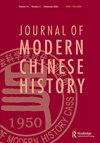Writing in wartime China: Chongqing, Shanghai, and Southern Zhejiang
IF 0.1
4区 历史学
Q4 HISTORY
引用次数: 0
Abstract
ABSTRACT The outbreak of the full-scale Sino-Japanese War (1937–1945) brought an end to the printing and publishing industry centered in Shanghai in the 1930s. Chongqing then emerged as a nerve center of information and opinion. Writers everywhere worked under wartime conditions of social dislocation, economic dependency, and political control. This article examines the writing and publishing of three notable pieces of work completed in wartime Chongqing, Shanghai, and southern Zhejiang, respectively. The article explores the context in which each work was written and then evaluates the broader significance of the texts with regard to a historical assessment of the Chinese intellectual experience during wartime.战时中国的写作:重庆、上海和浙江南部
抗日战争(1937-1945)的全面爆发,使20世纪30年代以上海为中心的印刷出版业走向终结。重庆随即成为信息和舆论的神经中枢。世界各地的作家都是在战时社会混乱、经济依赖和政治控制的条件下工作的。本文考察了战时分别在重庆、上海和浙江南部完成的三部著名作品的写作和出版情况。本文探讨了每一部作品的写作背景,然后评估了这些文本在战时对中国知识分子经验的历史评估方面的更广泛意义。
本文章由计算机程序翻译,如有差异,请以英文原文为准。
求助全文
约1分钟内获得全文
求助全文

 求助内容:
求助内容: 应助结果提醒方式:
应助结果提醒方式:


